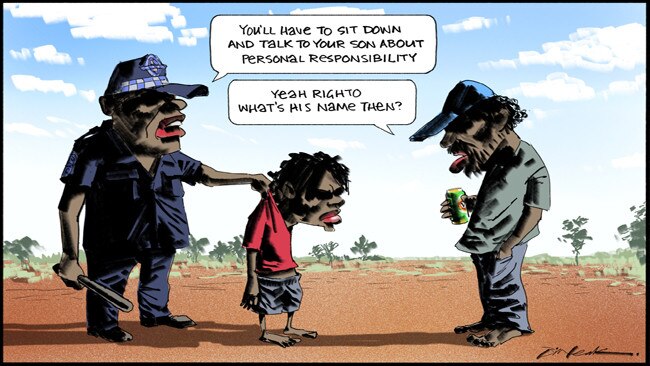Five years on, Bill Leak’s cartoon remains spot-on

As recently as Tuesday, a front-page story in this newspaper reported that in Western Australia, while some good work was being done to support Aboriginal families, more than half the children placed in care were Aboriginal.
For Bill’s persecutors, whom he referred to as the “offendarati”, it was another opportunity for them to do what they loved most – take offence, shout racism and be the centre of attention. Actually, it was an opportunity to do anything other than acknowledge that just maybe there was a problem with child abuse and neglect in Aboriginal communities.

Any accusation of Bill being racist was and still is ridiculous. I know this because Bill and I spent much time talking about the problems facing Aboriginal people, and he was deeply concerned for their plight. In the past, he had done some excellent cartoons defending them, so it beggars belief that he be called racist.
At the time of the cartoon, the neglect of Aboriginal children was nothing new; it was a topic this paper had reported on many times before and continues to do so responsibly today.
Consider a story by Nicolas Rothwell in which he wrote about the crisis in the Kimberley in 2011: “Pack rape is the most frequent mode of initiation into sex for pretty girls. These episodes are so distressing they rarely come out, but they show, of course, for years afterwards in the troubled behaviour of teenagers.” I can’t recall the outrage for this.
Three weeks after Bill’s cartoon appeared, Paige Taylor and Victoria Laurie wrote about Fitzroy Valley, “where children suffer among the world’s highest rates of brain damage caused by maternal drinking”. Where was the outrage?
Or consider an article by Taylor published nine days after Bill’s cartoon appeared, about WA’s Banksia Hill Juvenile Detention Centre, where the children, mostly Indigenous, looked forward to Family Day each July – an event that was bigger than Christmas. However, that year, 2016, only 45 of the 80 families who had said they would come actually turned up. Where was the outrage?
Taylor went on to say, “Such is life at the Banksia Hill Juvenile Detention Centre … where children learn they can depend on order in the system that incarcerates them, if not much elsewhere in their lives.” Where was the outrage? A welfare officer at the centre was reported to have said: “The kids openly tell us, ‘When I went home, you know, I went home to nothing, mum was drinking, so-and-so was taking drugs’.” Where was the outrage?
So why did Bill’s cartoon attract so much opprobrium yet the stories mentioned did not? I believe it was because his cartoon grabbed the reader’s attention immediately, and what gets your attention gets you.
News articles, no matter how well written, need to be read by interested people for their content to be noticed. But a good cartoon can be seen from across the room and hit you in your eyes, and this is what Bill did best: hit you in the eyes. He was just doing his job, which he did so brilliantly.
Early on the morning of Bill’s cartoon I emailed a copy of it to my father, Col Dillon, stating: “Dad, half of me was crying and the other half was laughing. Bill has an incredible talent that enables him to blend humour and tragedy without losing the seriousness of the situation.” My father, Australia’s first Aboriginal police officer, who admired Bill, said he agreed with my sentiments and offered Bill his full support in a conversation later that day, after Twitter went into meltdown with claims Bill was racist.
Bill, I wish I could say that since your cartoon we’ve made huge strides in eradicating the problem you were so deeply concerned about – the wellbeing of Aboriginal people, especially the children. But I can’t, because little has changed.
Consider an article from this newspaper in May that quotes from a report by the Australian Institute of Health and Welfare report on child protection: “Nearly one in six Aboriginal and Torres Strait Islander children accessed child protection services last year – eight times the rate of non-Indigenous children – and an increasing number of them are in out-of-home care … The number of Indigenous children removed from home – now 11 times the rate of non-Aboriginal children – has been described as a ‘national scandal’ by Labor and ‘horrifying’ by senior Indigenous figures.”
I can’t help but notice the failure to stem the continuing high rates of child abuse and neglect in the Aboriginal population is matched by a rise in what I call the deadly three: political correctness, identity politics and cancel culture. Fear of speaking out keeps us silent. This paper gave Bill a platform to speak out using his cartoons. We still miss you, Bill.
Anthony Dillon is a part-Aboriginal Australian, a researcher at Australian Catholic University and an Indigenous affairs commentator.







Five years ago today, The Australian published a cartoon by Bill Leak at which some sectors of the public expressed outrage at what they ostensibly believed was a racist depiction of Aboriginal people. But even casual followers of current events at the time would have known Bill’s cartoon was not racist but only reflected reality then, as it still does – Aboriginal children are more likely to suffer neglect and abuse than non-Aboriginal children.